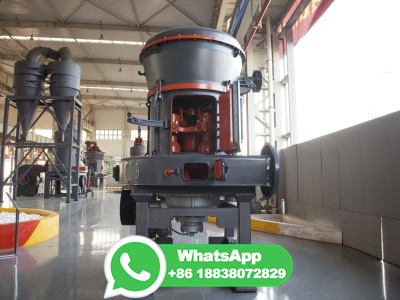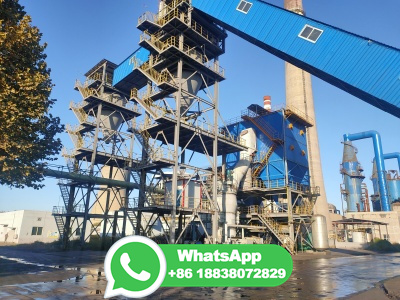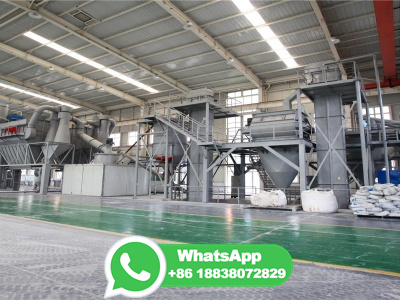
In industrial chemistry, coal gasification is the process of producing syngas—a mixture consisting primarily of carbon monoxide (CO), hydrogen (H 2), carbon dioxide (CO 2), methane (CH 4), and water vapour (H 2 O)—from coal and water, air and/or oxygen.. Historically, coal was gasified to produce coal gas, also known as "town gas".Coal gas is combustible and was used for heating and ...
WhatsApp: +86 18203695377
The FischerTropsch process (FT) is a collection of chemical reactions that converts a mixture of carbon monoxide and hydrogen, known as syngas, into liquid reactions occur in the presence of metal catalysts, typically at temperatures of 150300 °C (302572 °F) and pressures of one to several tens of FischerTropsch process is an important reaction ...
WhatsApp: +86 18203695377
Special Issue Information. This Special Issue focuses on coal conversion processes through the prism of the transition to CO2neutral energy production. The primary exploitation path of coal,, coal combustion for energy production, is strongly affected by CO2 emissionrelated penalties. Although the power sector is shifting to renewables ...
WhatsApp: +86 18203695377
CO 2 conversion to solid inorganic carbonates, also known as carbon mineralization, is a thermodynamically downhill route that can be adapted for integration with CO 2emitting energy and resource ...
WhatsApp: +86 18203695377
1. Introduction. Agreements on climate protection,, the Paris Climate Agreement [1] or the European Green Deal [2], aim to reduce CO 2 emissions in particular, which poses new challenges for all carbonconverting processes. In 2019, coal was still the second most common energy source for power generation worldwide [3], [4].To achieve climate protection goals, the use of fossil fuels ...
WhatsApp: +86 18203695377
The computed reorganization energy is of similar magnitude as obtained in previous simulations for the O 2toO ({}_{2}^{}) conversion 43,44. The reaction energy shows this reaction step is ...
WhatsApp: +86 18203695377
The hydrogen required for this method is produced using electrolysis processes with electricity generated from renewable energy sources. Overall, this could reduce carbon dioxide emissions by up to 97%. The decarbonization of the steel industry would therefore contribute significantly to protecting the climate.
WhatsApp: +86 18203695377
The coal conversion processes of the future prospect are plotted along with the current or demonstrated processes for electricity and/or H {sub 2} production. These efficiencies are given considering a CO {sub 2} controlled environment. The processes considered include subcritical and ultra supercritical PC processes retrofit with either MEA ...
WhatsApp: +86 18203695377
Biomass gasification is a mature technology pathway that uses a controlled process involving heat, steam, and oxygen to convert biomass to hydrogen and other products, without combustion. Because growing biomass removes carbon dioxide from the atmosphere, the net carbon emissions of this method can be low, especially if coupled with carbon ...
WhatsApp: +86 18203695377
Coal gasificationbased processes for conversion of coal to liquid fuels and chemicals have been in commercial operation for considerably longer than gasification for power generation. Methods for the conversion of coal to liquid fuels (CtL) have been available since the 1930s, but widespread acceptance of the technologies has been hindered by ...
WhatsApp: +86 18203695377
Coal liquefaction is a process of converting coal into liquid hydrocarbons: liquid fuels and petrochemicals. This process is often known as "Coal to X" or "Carbon to X", where X can be many different hydrocarbonbased products. However, the most common process chain is "Coal to Liquid Fuels" (CTL).
WhatsApp: +86 18203695377
A direct energy conversion device converts one form of energy to another through a single process. For example, a solar cell is a direct energy conversion device that converts optical electromagnetic radiation to electricity. While some of the sunlight that falls on a solar cell may heat it up instead, that effect is not fundamental to the ...
WhatsApp: +86 18203695377
Biofuels are fuels that are produced from combustion or processing of biomass a renewable energy source. These generate a lower carbon footprint across their lifecycle, when compared with fossil ...
WhatsApp: +86 18203695377
This chapter presents an assessment of the technologies that have evolved for the gasification of coal with a description of the current state of the art of the various technologies. Various types of coal are available such as lignite, subbituminous coal, bituminous coal, and anthracite. The gasification process involves two distinct stages ...
WhatsApp: +86 18203695377
The catalytic processes involved in coal conversion are mainly hydrogenation, oxidation, carboncarbon bond fracture and reconstruction, and the removal of pollutants.
WhatsApp: +86 18203695377
Most of the difference between these values was lost as an inherent result of the energy conversion process. The Energy Information Administration's (EIA) electricity flow diagram visualizes electricity flow from energy sources consumed to generate electricity and electricity net imports to disposition (conversion and other ...
WhatsApp: +86 18203695377
Currently, the only one productionally common method for preparing coal for pulverized combustion is the gravity concentration (on concentration tables or mainly by jigging), in which most part...
WhatsApp: +86 18203695377
Transporting coal. Coal can be transported from mines and processing plants to consumers in several different ways: Conveyors, trams, and trucks move coal around mines, for short distances from mines to that are consumers close to the mines, or to other modes of longdistance transportation. Trains transport nearly 70% of coal deliveries in the ...
WhatsApp: +86 18203695377
Although the processing of coal is an ancient problem and has been practiced for centuries, the constraints posed on today's coal conversion processes are unprecedented, and utmost innovations are required for finding the solution to the a strong demand for an affordable energy supply which is compounded by the urgent need for a CO2 emission control, the clean and efficient ...
WhatsApp: +86 18203695377
Electron spin resonance (ESR) is a spectroscopic method to detect paramagnetic species, which has been applied in coal and coal conversion research over 60 years. The major advancements made before 1990s were reviewed but the studies and findings reported since then have not been reviewed. The recent studies not only showed new phenomena on ESR radical behaviors associated with coal conversion ...
WhatsApp: +86 18203695377
The possibilities for reducing mercury, arsenic and thallium emission from coal conversion processes. ... a part of these elements are released into the atmosphere. For this reason, coal processing is one of the main sources of their emissions to the environment. Particular attention should be paid to the emission of such elements as mercury ...
WhatsApp: +86 18203695377
As coalplant operators seek ways to repurpose their old units to avoid them becoming stranded assets, conversion to natural gas has been a widelyadopted strategy in the US and is also favoured by Alberta, Canadabased TransAlta. Between 2011 and 2019, 121 coalfired units in the US were repurposed to burn other types of fuel, according to the ...
WhatsApp: +86 18203695377
The coal is converted into a complex mixture of gaseous hydrocarbons with heat values ranging from 100 Btu to 1000 Btu. One suggestion has been to construct gasification systems within a coal mine, making it much easier to remove the coal (in a gaseous form) from its original seam. In the process of liquefaction, solid coal is converted to a ...
WhatsApp: +86 18203695377
Coal Pyrolysis khan 2000, Ullmann's Encyclopedia of Industrial Chemistry Free PDF Enrichment of reactive macerals in coal: its characterization and utilization in coke making Prasad Kopparthi Metallurgical Research Technology Macerals in coal are of different types: reactive and inert.
WhatsApp: +86 18203695377
Coal and biomass are important feedstocks for carbon energy from thermochemical conversion process. Fully understanding the analytical technology that characterizes the changes in physicochemical properties and structural characteristics of coal and biomass during the thermochemical reactions is a key prerequisite for the realization of appropriate utilization of energy fuels.
WhatsApp: +86 18203695377
Influence of coal properties on coal conversion processal carbonization, carbon fiber . 123 Table 5 Coal parameters with significant influence on liquefaction process
WhatsApp: +86 18203695377
ICL processes first convert coal to a gaseous intermediate, which is then converted to liquid fuel. Coal gasification technologies rely on incomplete combustion, wherein coal is heated with a quantity of air that is insufficient to allow complete combustion (formation of carbon dioxide and water). The products are condensables and tars ...
WhatsApp: +86 18203695377
Coal Conversion In addition to its direct use for combustion, coal can be converted to organic gases and liquids, thus allowing the continued use of conventional oil and gasfired processes when oil and gas supplies are not available. Currently, there is little commercial coal conversion in the United States.
WhatsApp: +86 18203695377
The main conversion steps of pyrolysis and char consumption are characterized by numerous phenomena, which have to be addressed by coal conversion models. Often, these models focus on one conversion step, describing either coal pyrolysis or char consumption.
WhatsApp: +86 18203695377
Thermalbased power plants can produce electricity from coal or other fuel sources. The coalfired process requires three different steps to turn energy released from burning coal to generating electricity for consumption. Coal fired power plants, while producing power, require a lot of water and produce a lot of pollutants like ash and CO2. Learn how the process works as well as interesting ...
WhatsApp: +86 18203695377
Most and world electricity generation is from electric power plants that use a turbine to drive electricity generators. In a turbine generator, a moving fluid—water, steam, combustion gases, or air—pushes a series of blades mounted on a rotor shaft. The force of the fluid on the blades spins (rotates) the rotor shaft of a generator.
WhatsApp: +86 18203695377